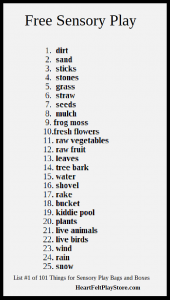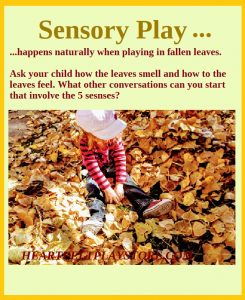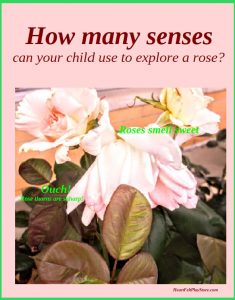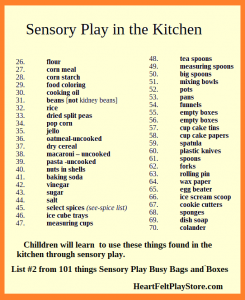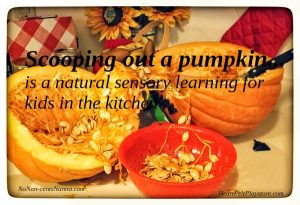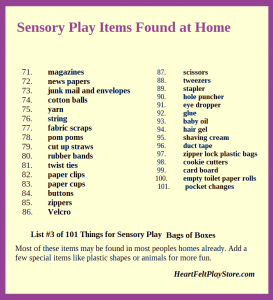101 Things for Sensory Play
What is big deal and why is sensory play important to how children learn?
And, what is a Busy Bag or a Busy Box? This post will explain along with 100 things to use for sensory play to put collections of bags and boxes for children to play and learn.
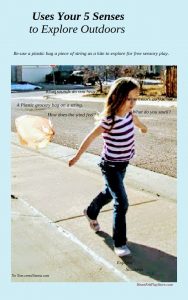
Sensory play out doors. The explore the wind re-use a plastic grocery bag with a string tied to the handles for a kite.
We all can name the 5 senses: sight, smell, sound, taste and touch. Assuming our bodies are functioning well, the more senses that the be incorporated into our learning experience the more quickly we grasp and retain a subject. This concept is particularly true with how children learn-with their senses.
Parents and teachers do not have to spend a fortune to offer learning experiences to their children/students.
The whole wide natural world is full of wonderful sensory experiences that are pretty much free.
The first 25 items on my list below are found in the great outdoors. Most are free with last few being tools to use outside.
I will share a few photos that I have snapped while I was playing with my grand children. Since this subject of sensory play is so vast that teachers have written 100’s of books and millions of Pinterest images I am going to simply give you the click to my growing Pinterest board: Click on the title to start re-pinning nearly a 1,000 or more pins with ideas and recipes.
- dirt
- sand
- sticks
- stones
- grass
- straw
- seeds
- mulch
- frog moss
- fresh flowers
Have you ever thought about a conversation being sensory? Why do you think I ask about why talking is sensory?
- raw vegetables
- raw fruit
- leaves
- tree bark
- water
- shovel
- rake
- bucket
- kiddie pool
- plants
- live animals
- live birds
- wind
- rain
-
snow
Children can learn so many skills for their future in the kitchen
Note: Parents please use wise discretion when playing in the kitchen.
- developmental stages
- age appropriateness
- safety
Learning “naturally” should be fun-never a chore.
Sure kids do learn from having chores to do, too.
Scooping out Pumpkins Questions for Kids.
It’s Fall ya’all! And almost time for pumpkins! What a wonderful time of year for families to explore with every one of the 5 senses we can. Below area few ideas on how to get a conversation started.
- What color, size, shape is a pumpkin?
- How does a pumpkin feel on the outside? Inside?
- What does a pumpkin smell like?
- What sound does a pumpkin make if you knock in the outside before cutting?
- What does raw pumpkin taste like?
- What seasonings shall we put in the pumpkin seeds before we bake them?
Mom and Dad, you should be the ones to use a big ole knife to cut a pumpkin in half then let the kids dig in to scoop and explore.
- Pumpkin seeds get on the floor
- do the task out side of put news papers on the floor.
- Children will learn natural consequences for dropping seeds or pumpkin guts.
- What kitchen will clean up the mess best? Why?
Scooping out a pumpkin is a fun fall sensory learning experience for the family. –see post
Food for Sensory Play
I have strong reservations about how food is used for sensory play/ learning.
OK. I am going to pull the Mother-Guilt thing that is not helpful in a child’s thinking process.
“Sweetie, eat you liver. Just think about all the starving children in Africa. Why they would grateful to have a bite of broccoli and liver.”
- Use food for the purpose of sensory play how we prepare food naturally avoiding arts and crafts made with food unless you plan to eat the finished product.
- In general, we parents and teachers do not ever want to give children that idea that it is OK to waste food.
- In my opinion substituting something edible for a non-edible material ingredient.
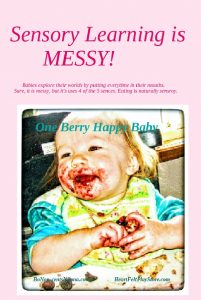
When a baby feeds him/ herself they are learning by using 4 of 5 senses. Sure it is messy. But it is naturally they way babies learn.
When a baby feeds him/ herself they are learning by using 4 of 5 senses.
- Sure it is messy. But it is naturally they way babies learn.
- Set the boundaries for nourishing our bodies time and play time.
State: It is time to eat. or Which would you like to eat first? The orange carrots or the green beans?
What do you want your child to do with food?
- You are the parent/ teacher. States and follow rules for eating and playing
- Use your words to tell the child * what you want them to do with their food.
- Avoid using words that are the * opposite of what you do want them to do.
Time to eat now. Show me how you cut the banana with the butter knife.
or
Does your banana smell sweet?
versus
Don’t smear you food on the table.
Stopping dropping your spoon on the floor. ( Baby may like the clunk when it hits the floor.)
Don’t pour your milk on the floor.
Yes, parents, /teachers there needs too be consistent rules for eating and playing. Tell your child what exactly you want them to do vs what you don;t want them to focus on.
I doubt your child can read your mind, so state the rules clearly
- We are eating orange carrots and blue berries with our brown toast.
- Our farm animals got in the mud. We will have to give them a bath, now. M-m-m our pretend mud tastes like something. What is it.
Food as a Sensory Play Medium
Be sure to tell the children that this is for pretending and we are allowed to taste the pretend mud.
- Chocolate pudding or Cocoa Powder for DIRT
- Gummy Worms to decorate a “dirt cake”.
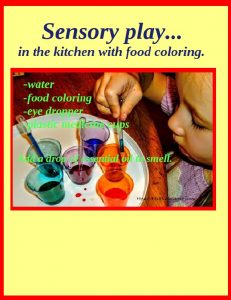
Sensory play in the kitchen with water, food coloring eye dropper. Add a drop of essential oil to smell. Start the conversation with your child about using the 5 senses here-see post
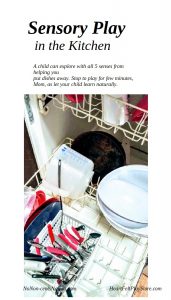
Dishes in the dish water when clean make great sensory play in the kitchen. How many senses can you list on how your child can explore when they use the thing in my dish washer?
- dirt
- sand
- sticks
- stones
- grass
- straw
- seeds
- mulch
- frog moss
- fresh flowers
- raw vegetables
- raw fruit
- leaves
- tree bark
- water
- shovel
- rake
- bucket
- kiddie pool
- plants
- live animals
- live birds
- wind
- rain
- snow
- flour
- corn meal
- corn starch
- food coloring
- cooking oil
- beans [not kidney beans]
- rice
- dried split peas
- pop corn
- jello
- oatmeal-uncooked
- dry cereal
- macaroni – uncooked
- pasta -uncooked
- nuts in shells
- baking soda
- vinegar
- sugar
- salt
- select spices (see-additional list)
- ice cube trays
- measuring cups
- tea spoons
- measuring spoons
- big spoons
- mixing bowls
- pots
- pans
- funnels
- empty boxes
- empty boxes
- cup cake tins
- cup cake papers
- spatula
- plastic knives
- spoons
- forks
- rolling pin
- wax paper
- egg beater
- ice scream scoop
- cookie cutters
- sponges
- dish soap
- colander
- magazines
- news papers
- junk mail and envelopes
- cotton balls
- yarn
- string
- fabric scraps
- pom poms
- cut up straws
- rubber bands
- twist ties
- paper clips
- paper cups
- buttons
- zippers
- Velcro
- scissors
- tweezers
- stapler
- hole puncher
- eye dropper
- glue
- baby oil
- hair gel
- shaving cream
- duct tape
- zipper lock plastic bags
- cookie cutters
- card board
- empty toilet paper rolls
- pocket change
What do you do with a Busy Bag or a Busy Box?
A Busy Bag or a Busy Box is a safe child-size container to hold sensory play things until it’s time to play.
What the stuff in a Busy Bag or Busy Box kind-of sort-of does not really matter as long as…
- safe
- developmental-age appropriate
- holds the child’s interest for a reasonable time
- no rules – just interesting things to explore by sorting, counting, feeling , tasting, seeing, smelling or hearing
Note from No Non-cents Nanna
- I could write about 101 pages with more ideas of household tools your child can learn from, but, typing fingers need a rest…or less is more?
- I hope this uniquely inspires you mothers, fathers, grand parents, pre-k teachers from the perspective of an old Nurse and Early Childhood Educator.
- Did my word give you a new or enhanced perspective on sensory learning?
More No Non-cents Nanna’s Posts on Sensory Play
Shameless Self Promotion:
I am Malika Bourne author of No Non-cents Nanna blog. I was also the founder and owner of Heart Felt Play Store – now retired.
My goal was to offer fun stuff for kids with an educational twist. I offered a variety of sensory play items that you can purchase to enhance learning using some of the 101 things I listed above.
Follow Heart Felt Play on Facebook
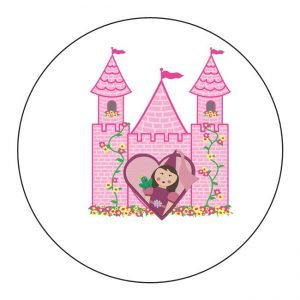
Heart Felt Play Store has a big heart for kids health and wellness . Explore Heart Felt Play Store .com
Views: 608

